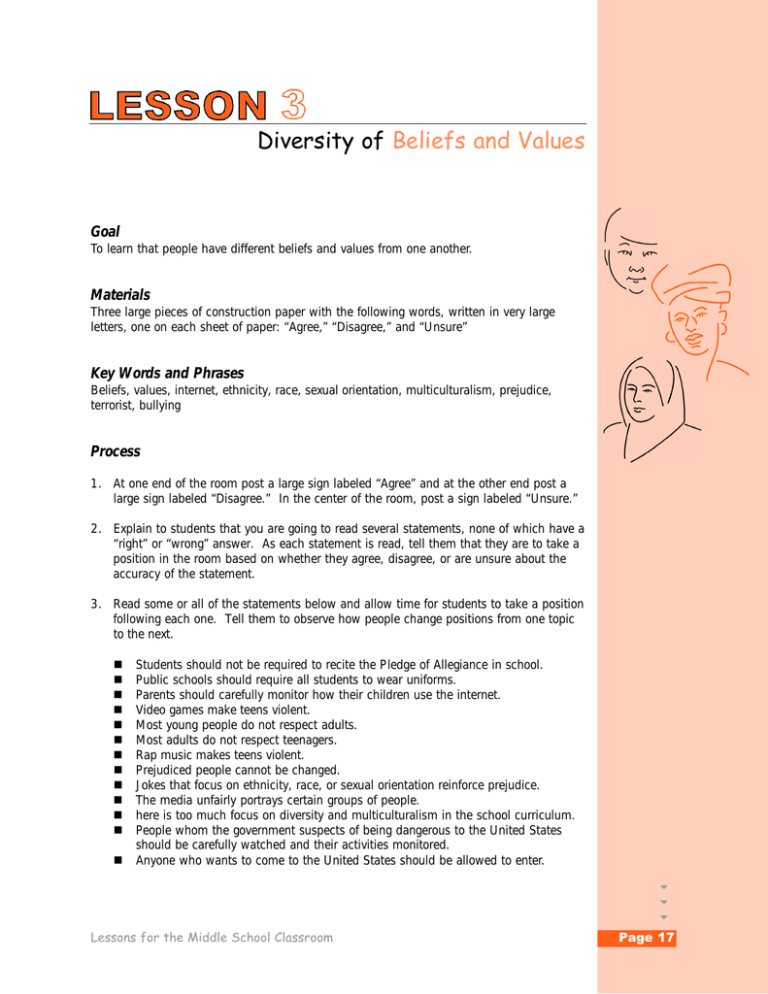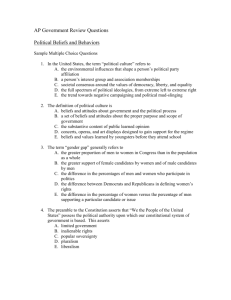Diversity of Beliefs and Values
advertisement

Diversity of Beliefs and Values Goal To learn that people have different beliefs and values from one another. Materials Three large pieces of construction paper with the following words, written in very large letters, one on each sheet of paper: “Agree,” “Disagree,” and “Unsure” Key Words and Phrases Beliefs, values, internet, ethnicity, race, sexual orientation, multiculturalism, prejudice, terrorist, bullying Process 1. At one end of the room post a large sign labeled “Agree” and at the other end post a large sign labeled “Disagree.” In the center of the room, post a sign labeled “Unsure.” 2. Explain to students that you are going to read several statements, none of which have a “right” or “wrong” answer. As each statement is read, tell them that they are to take a position in the room based on whether they agree, disagree, or are unsure about the accuracy of the statement. 3. Read some or all of the statements below and allow time for students to take a position following each one. Tell them to observe how people change positions from one topic to the next. n n n n n n n n n n n n n Students should not be required to recite the Pledge of Allegiance in school. Public schools should require all students to wear uniforms. Parents should carefully monitor how their children use the internet. Video games make teens violent. Most young people do not respect adults. Most adults do not respect teenagers. Rap music makes teens violent. Prejudiced people cannot be changed. Jokes that focus on ethnicity, race, or sexual orientation reinforce prejudice. The media unfairly portrays certain groups of people. here is too much focus on diversity and multiculturalism in the school curriculum. People whom the government suspects of being dangerous to the United States should be carefully watched and their activities monitored. Anyone who wants to come to the United States should be allowed to enter. 6 6 6 Lessons for the Middle School Classroom Page 17 n n n Since the World Trade Center and Pentagon terrorist attacks, the world is no longer safe anywhere. Bullying is a normal part of adolescent behavior. School violence is a major problem in this country. 4. Ask students to make general observations about the lesson and to explain how they felt sharing their opinions on some of the topics. Guide a whole-group discussion using some or all of the following questions: a. How did it feel to take a position on some of the topics? b. If there was a particular topic that you were unsure about, what information would you need in order to form an opinion? c. How did you feel when you saw others taking a completely different position from yours on a topic? Were any of your classmates’ opinions surprising to you? Explain. d. Was there a statement read where you were clearly in the minority in your position? Did you consider changing your position to conform to the majority? Why or why not? e. What do you think was the purpose of this lesson? f. How does the variety of beliefs and opinions that people hold present challenges when people work and live together? How can different opinions be beneficial? g. Do you think people sometimes pretend to agree with another person in order to avoid conflict? h. Do you think it likely that people change their opinions on topics like the ones presented in this lesson? If so, what kinds of things are likely to cause opinions to change? 5. In small groups have students discuss the lesson. Instruct them to consider the various ways that people come to hold their beliefs, opinions, and values and make a list on a piece of paper. After all groups have completed the discussion, prepare a composite list of their responses on chart paper or on the board. 6. As an additional activity, encourage students to ask their parents or other family members the same questions and compare those responses to their own. NOTE: Have the list of statements duplicated for students to take with them for this activity. Connection to Standards Language Arts: Listening and Speaking < Uses listening and speaking strategies for different purposes Life Skills: Working With Others < Contributes to the overall effort of a group Civics < Understands the importance of Americans sharing and supporting certain values, beliefs, and principles of American constitutional democracy 6 6 6 Page 18 Behavioral Standards < Understands various meanings of social group, general implications of group membership, and different ways that groups function Building Community and Combating Hate

